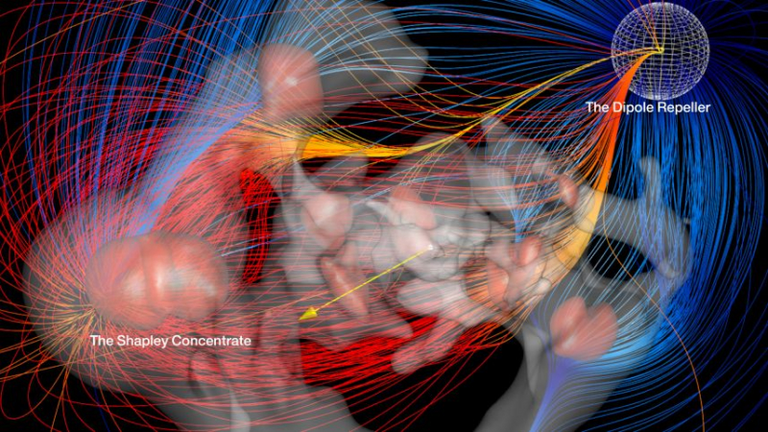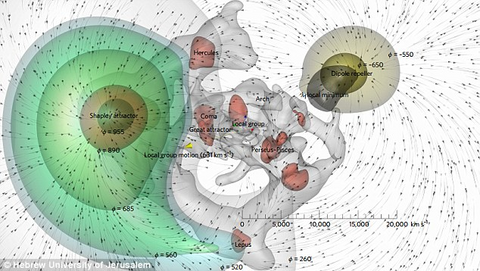The Great Dipole Repeller
Until now, scientists assumed that a dense region of the universe is pulling us toward it, in the same way that gravity made Newton's apple fall to earth. The initial "prime suspect" was called the Great Attractor, a region of a half dozen rich clusters of galaxies 150 million lightyears from the Milky Way. Soon after, attention was drawn to an area of more than two dozen rich clusters, called the Shapley Concentration, which sits 600 million lightyears beyond the Great Attractor, which is not an object but instead a point in the center of the supercluster of galaxies in which our Milky Way exists.
Although we can't feel it, we're in constant motion: the earth spins on its axis at about 1,600 km/h; it orbits around the sun at about 100,000 km/h; the sun orbits our Milky Way galaxy at about 850,000 km/h; and the Milky Way galaxy and its companion galaxy Andromeda are moving with respect to the expanding universe at roughly 2 million km/h (630 km per second). But what is propelling the Milky Way's race through space?
Exciting new research shows that our galaxy is not only being pulled, but also pushed. In a new study in Nature Astronomy, researchers describe a previously unknown, very large region in our extragalactic neighborhood. Largely devoid of galaxies, this void exerts a repelling force on our Local Group of galaxies.
"By 3-d mapping the flow of galaxies through space, we found that our Milky Way galaxy is speeding away from a large, previously unidentified region of low density. Because it repels rather than attracts, we call this region the Dipole Repeller," said Prof. Yehuda Hoffman. "In addition to being pulled towards the known Shapley Concentration, we are also being pushed away from the newly discovered Dipole Repeller. Thus it has become apparent that push and pull are of comparable importance at our location."

"We live in a universe that is expanding and has been ever since the Big Bang," Hoffman explains. The basic theory of cosmology states that to a very good approximation the universe is uniform - the same everywhere - a perfect symmetry.
If everything were uniformly dense, there would be nothing to cause a galaxy to deviate from its original trajectory and speed, Hoffman says.
"But, the universe is not homogenous. It is not uniform in the distribution of material: some areas are denser, more crowded with material and galaxies. Some areas are emptier relative to the mean density of the universe. Nor do all galaxies move at the same speed. Some deviate from the speed that would have resulted from a uniform universe."
The Milky Way is moving at 2.3 million kilometers an hour in respect to the expanding universe.
"Effectively, if all directions are pulling hard but from one direction, there is only a weak gravitational force, it behaves relatively like a repellent," Hoffman explains.
Ergo, the great Dipole Repeller that the team found is actually a region pulling more weakly relative to two dense areas powerfully pulling the Milky Way and a host of other galaxies, which have been dubbed the "Great Attractor" and the "Shapley Concentration."

The presence of such a low density region has been suggested previously, but confirming the absence of galaxies by observation has proved challenging. But in this new study, Hoffman, at the Hebrew university's Racah Institutes of Physics, working with colleagues in the USA and France, tried a different approach.
Using powerful telescopes, among them the Hubble Space Telescope, they constructed a 3-dimensional map of the galaxy flow field.
Flows are direct responses to the distribution of matter, away from regions that are relatively empty and toward regions of mass concentration; the large scale structure of the universe is encoded in the low field of galaxies.
They studied the peculiar velocities - those in excess of the Universe's rate of expansion - of galaxies around the Milky Way, combining different datasets of peculiar velocities with a rigorous statistical analysis of their properties. They thereby inferred the underlying mass distribution that consists of dark matter and luminous galaxies—over-dense regions that attract and under-dense ones that repel.
By identifying the Dipole Repeller, the researchers were able to reconcile both the direction of the Milky Way's motion and its magnitude. They expect that future ultra-sensitive surveys at optical, near-infrared and radio wavelengths will directly identify the few galaxies expected to lie in this void, and directly confirm the void associated with the Dipole Repeller.
The Dipole Repeller: The Movie
Haaretz: It's an imperfect universe...
Galaxies don’t just sit idle twinkling and enjoying the expansion of the universe. They hurtle through space, moving fast in a fashion not associated with the universal expansion. Our home galaxy, the Milky Way galaxy, is moving at about 630 km per second, or roughly 2.3 million kilometers per hour, with respect to the rest of the universe. This motion has puzzled astronomers since its discovery some 40 years ago. Now a team of scientists led by Prof. Yehuda Hoffman of Hebrew University [Jerusalem] has pinpointed the cause of that motion.
Moreover, the scientists have identified a previously unknown vast region sparsely populated by galaxies which affects the motion of our Milky Way.
"By 3-d mapping the flow of galaxies through space, we found that our Milky Way galaxy is speeding away from a large, previously unidentified region of low density. Because it repels, we call this region the Dipole Repeller,” says Hoffman, who spoke with Haaretz about the research published in Nature Astronomy.
It's an imperfect universe. The original impetus for the motion of galaxies is the Big Bang, Hoffman explains to Haaretz. But some galaxies are moving faster, or slower, than the impetus from that seminal burp over 14 billion years ago would dictate.
In the absence of divine intervention, this deviation from the pure primordial expansion begs explaining. "We live in a universe that is expanding and has been ever since the Big Bang," Hoffman explains. The basic theory of cosmology states that to a very good approximation the universe is uniform - the same everywhere - a perfect symmetry.
If everything were uniformly dense, there would be nothing to cause a galaxy to deviate from its original trajectory and speed, Hoffman says. But reality is an ass, and the universe is not homogenous. It is not uniform in the distribution of material: some areas are denser, more crowded with material and galaxies. Some areas are emptier relative to the mean density of the universe. Nor do all galaxies move at the same speed. Some deviate from the speed that would have resulted from a uniform universe. Now: All matter is pulled alike by gravitational force; all matter responds alike to gravity. The Milky Way experiences the gravitational pull of the rest of the universe. In a perfectly homogenous universe, this gravitational pull coming from all directions would cancel out. However, irregularities in the matter distribution ruin this perfect cancellation of force.
Over-dense regions exert a gravitational pull and hence act as attractors. Under-dense regions exert a weaker force and – compared with the rest of the universe - their gravitational force becomes repulsive.
"Effectively, if all directions are pulling hard but from one direction, there is only a weak gravitational force, it behaves relatively like a repellent," Hoffman explains.
Ergo, the great Dipole Repeller that the team found is actually a region pulling more weakly relative to two dense areas powerfully pulling the Milky Way and a host of other galaxies, which have been dubbed the "Great Attractor" and the "Shapley Concentration" (of galaxies) The Great Attractor is a thickly populated region of the universe, with half dozen densely populated clusters of galaxies, about 150 million light-years from the Milky Way. The Shapley Supercluster, or Shapley Concentration, housing more than two dozen thickly populated clusters, is 600 million light-years beyond the Great Attractor. The Dipole Repeller isn't actually repelling anything per se, it's attracting, just rather weakly. Prof. Hoffman helpfully explains the definitions using the height of men. Say the average height of Israeli adult men is 170 centimeters, he says. A man 180 centimeters tall would be +10cm to the average but a man 160 centimeters tall would be -10.
Finding the Dipole Repeller sounds simple – look into space, see great big empty spot. No? No. First of all, it isn't empty, but the number of galaxies there is less than would be expected in a uniform universe, Hoffman explains.
"If in a given volume of space one expects to find 1,000 galaxies but finds only 500 – I call that very empty. In relative terms, its density is -50% of what should be, which is a lot."
How hadn't science noticed this great whacking not-quite-empty space until now? Yes, the (fewer) galaxies there also naturally shine, Hoffman explains. But galaxies in very empty areas emit less light than those in dense areas. They are less luminous and are less of them, so they are harder to find. Historically, astronomers aimed their telescopes at easier areas; one doesn't look for one's missing wallet in the dark, but under the light where one can see, he shrugs over the phone.
So how did Hoffman with colleagues in France and the United States find this great under-dense space they call the Dipole Repeller? They looked at the peculiar velocities – those in excess of the Universe’s rate of expansion – of galaxies around the Milky Way. Using powerful telescopes, including the famous orbiting Hubble, combined with sophisticated mathematical modeling, they created a 3-dimensional map of the motion of galaxies – what they call "the galaxy flow field". (See the attached video.) Flows are direct responses to the distribution of matter, away from regions that are relatively empty and toward regions of mass concentration; the large scale structure of the universe is encoded in the flow field of galaxies, they explain. They inferred the underlying distribution of mass (meaning both luminous galaxies and dark matter), to identify over-dense regions that attract and under-dense ones that repel. Their biggest surprise was to find that the Milky Way and the Andromeda galaxies are roughly equally repelled by the Dipole Repeller and attracted by the Shapley Concentration.
The Dipole Repeller as they envision it would reconcile both the direction of the Milky Way’s motion and its velocity, and there you have it.
Ruth Schuster,
January 30, 2017
Poussée par un vide, notre galaxie surfe à plus de 2 millions de km/h
x
Articles in Q-MAG.org
Cyprus salt lakes exonerate Peoples of the Sea from destroying Bronze Age civilizations
Toppling Rome's obelisks and aqueducts
Trevor Palmer's response to Gunnar Heinsohn
Jan Beaufort: Conspiracy or religious history?
Gunnar Heinsohn's answer to Trevor Palmer
G.H.: Vikings without towns, ports and sails...
Trevor Palmer challenges Gunnar Heinsohn
The 1st Millennium AD controversy
The exact dates of the deaths of Patroclus and Hector
Lybian rock-art erased by Jihadists
The tsunami that obliterated Doggerland
Miles below ground, live the creatures of the Deep
Navigation systems of migratory birds suffer from electromagnetic fields
G.H.: Charlemagne's correct place in history
The petroglyph sundial of Mount Bégo
Mount Bégo: an electrical mountain

